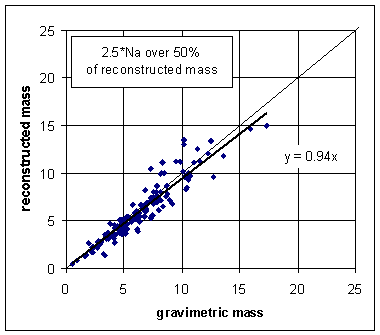|
|
|
|
CNL Report: Factor for Na in reconstructed massMarch 8, 2001 Author: Robert
Eldred The CNL codes use a multiplicative factor of 2.5 for Na,
which assumes that Na is present as NaCl.
To determine if this is reasonable, I compared the measured
and reconstructed fine masses for those samples in which 2.5*Na contributes at
least 50% of the reconstructed mass.
The results for samples collected between 3/97 and 11/99 are shown in
Figure 1. The reconstructed mass
accounts for 94% of the measured mass.
This is closer to unity than for the entire data set, which has a slope
of 87%. To give a slope of unity, the
factor would have to be 2.75. The
conclusion is that 2.5 is a reasonable value.
Note 1: NaCl is very
hygroscopic, so we would expect the measured mass to be greater than for dry
NaCl. Note 2: The accuracy
for Na is considerably worse than for most elements, since it is at the low
energy extreme of the x-ray spectrum, and has the largest x-ray absorption
matrix factor of any element. (This
matrix factor compensates for Na x-rays absorbed in the particles.) The fact that we get good agreement with
measured mass indicates that the accuracy error cannot be major. Note 3: All of the samples were from marine sites. The factor might be different at non-marine sites. However, Na is a major contributor to reconstructed mass only at marine sites.  Figure 1. Comparison
of measured and reconstructed mass for samples in which 2.5*Na accounted for
over 50% of the reconstructed mass.
Samples collected between 3/97 and 11/99. All of the samples were from marine sites. |